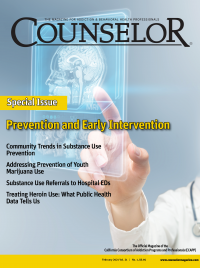Share

Everyone has heard the famous saying by Benjamin Franklin, “An ounce of prevention is worth a pound of cure” (Medrut, 2018). This saying was meant to convey the idea that it takes less effort to prevent a problem than it does to fix a problem once it develops. This truth is very applicable to the addiction crisis we are facing today in the US.
According to the Partnership to End Addiction, “Of every federal and state dollar spent, 96 cents goes to shovel up wreckage of illness, crime, social ills; only 2 cents goes to prevention and treatment” (2009). While this report was published in 2009, it was not until very recently that substance use disorder (SUD) prevention has seen any significant increase in funding. Federal and state governments seem stuck in the spin cycle of always dealing with the problem after the fact, and the cost is high in terms of loss of life, loss of human potential, and tax dollars spent.
We are dealing with an issue that may not have been a crisis if we had been more preemptive in investing in prevention and early intervention approaches.
Most of my ten-year career in SUD services has been dedicated to treatment primarily in governmental settings; only recently was I was assigned to SUD primary prevention contracts. SUD prevention is very different from SUD treatment and I only realized how siloed these two arenas were when I encountered my own knowledge deficits on the subject of prevention. In working to develop the strategic prevention plan (SPP) for my county, I very quickly became aware of the massive funding disparity between SUD prevention and treatment. SUD primary prevention generally operates on a portion of Substance Abuse Prevention and Treatment Block Grant (SABG) funds, along with funds from other prevention-focused grants. According to the California Department of Health Care Services (DHCS):
U.S.C. Title 42, Section 300x-22(a) requires the State to spend a minimum of 20 percent of the total SABG Award to California on primary prevention services. For SFY 2020-21, California is prioritizing prevention, which is defined as strategies, programs, and services directed at individuals who have not been determined to require treatment for a substance use disorder. As a result, DHCS has increased each county’s Primary Prevention Set-Aside amount to equal 25 percent of their total SFY 2020-21 allocation (2020).
Even though SUD prevention was granted a 5 percent increase under SABG, the remaining 75 percent of the SABG grant money is generally used for SUD treatment and/or ancillary services that support treatment and recovery. To further demonstrate the massive funding disparity, SABG funds are not even the primary source of funding for SUD treatment in the public system—in California, Drug Medi-Cal (DMC) funds most public treatment services. From my perspective, it seems the amount of resources dedicated to a particular solution to a problem is a strong indicator of the political will available to fix the problem. Lack of political will, as it relates to SUD prevention, may be due to the general ignorance of the wide range of societal consequences caused by not working to prevent SUDs before they develop.
In the documentary film about Tonier Cain, Healing Neen (Cain & Gross, 2010), Pat Shae, MSW, MA, the deputy director of the Office of Technical Assistance at National Association of State Mental Health Program Directors (NASMHPD) states:
The problem is that we are not a prevention-oriented society. We tend to be very reactive instead of proactive. We like to look at the emergency that’s right at hand and when it comes to funding, prevention programs are just sort of seen as fluff. If there’s extra money left over, if we get a grant, then maybe we’ll pay for prevention, but otherwise we don’t want to invest resources. It just doesn’t make sense. It’s like saying we can’t possibly spend money installing seatbelts in cars because we have to spend all of our money over here stitching up people’s foreheads.
This quote was referencing prevention practices for child maltreatment, but it is amazing how applicable her points are to SUD prevention.
I spent twenty years of my life addicted to opioids, methamphetamine, alcohol, and/or other substances. For fifteen years, I was in and out of treatment programs, jails, prisons, and psychiatric care. My addiction destroyed my relationships, cost me jobs and educational opportunities, kept me broke, and cost tax payers money for treating my addiction, housing me in detention facilities, and monitoring me on probation and parole. Ultimately, addiction cost me decades of my life. Like many others in recovery, my passion to help others recover from the horrors of addiction led me into the addiction treatment profession, but for many years I have wondered if my life could have been different had our society been fully committed to prevention and/or early intervention approaches and I accessed those services. While I am in recovery and doing well, the disease of addiction walked me down a path that has left me scarred mentally and emotionally. Those of you who, like me, made it into recovery and rebuilt your lives, we are the fortunate ones. You only have to look at the rising death toll from drugs and alcohol in the US over the last five years to be grateful. Many never get the chance to recover. People who are addicted suffer, their families and loved ones suffer, and society suffers. Once addiction develops there is no cure, only remission. We cannot unring a bell once it has been rung.
In recent years, the opioid crisis has shed light and brought awareness to the disease of addiction. Drugs and alcohol have been destroying lives for centuries, but better late than never. However, we as a society are now in “crisis mode.” We are dealing with an issue that may not have been a crisis if we had been more preemptive in investing in prevention and early intervention approaches. Currently the focus is opioids, and now methamphetamine creeping onto the national radar. Tomorrow it will be another drug. However, the drug is not the issue, addiction is the issue, and addiction has known risk factors that contribute to its development. The good news is that there are also known protective factors that reduce risk factors—that is what SUD prevention strives to accomplish: reducing risk factors while strengthening protective factors.
At the present time, SUD treatment is critical and additional funding for innovative treatment approaches is welcome. However, thinking long term, just as society discovered that we cannot incarcerate our way out of the addiction problem, I believe we will discover that we cannot treat our way out of it either. The addiction treatment industry does not exist to support the lives of its workers. We should be doing our best to work ourselves out of a job. Our industry exists to help bring an end to the devastation caused by addiction, and the best way to do that is to prevent it from developing. As people involved in the treatment industry, we should be the strongest advocates for significant increases in SUD prevention funding.
References
- Cain, L., & Gross, D. (2010). Heeling Neen [film]. In the Hollow Films.
- Department of Health Care Services (DHCS). (2020). 2020 behavioral health information notices. Retrieved from https://www.dhcs.ca.gov/formsandpubs/Pages/2020-BH-Information-Notices.aspx
- Medrut, F. (2018). Fifteen Benjamin Franklin quotes to make you wiser. Retrieved from https://www.goalcast.com/2018/01/30benjamin-franklin-quotes/
- Partnership to End Addiction. (2009). New CASA report finds federal, state, and local governments spend almost half a trillion dollars a year on substance abuse and addiction. Retrieved from https://drugfree.org/drug-and-alcohol-news/new-casa-report-finds-federal-state-and-local-governments-spend-almost-half-a-trillion-dollars-a-year-on-substance-abuse-and-addiction/
About Me
Michael Prichard M.S., LAADC, ICAADC, currently serves as Vice Chair and Legislative Chair for the California Consortium of Addiction Programs and Professionals (CCAPP). He holds a master’s of science in addiction counseling, is a Staff Analyst in SUD Prevention for Fresno County Department of Behavioral Health, and is contracted trainer for Central California Training Academy through California State University, Fresno Foundation.













 Counselor Magazine is the official publication of the California Association of Addiction Programs and Professionals (CCAPP). Counselor offers online continuing education, article archives, subscription deals, and article submission guidelines. It has been serving the addiction field for more than thirty years.
Counselor Magazine is the official publication of the California Association of Addiction Programs and Professionals (CCAPP). Counselor offers online continuing education, article archives, subscription deals, and article submission guidelines. It has been serving the addiction field for more than thirty years.